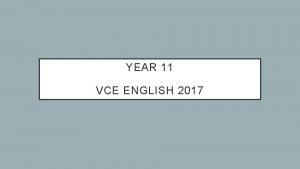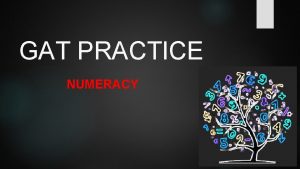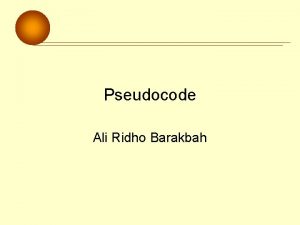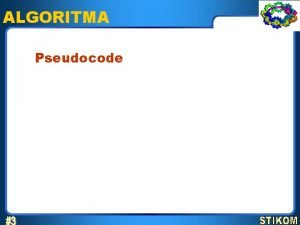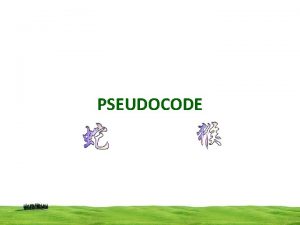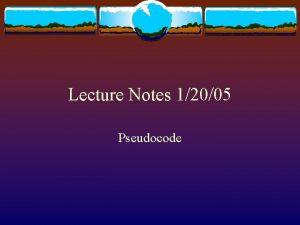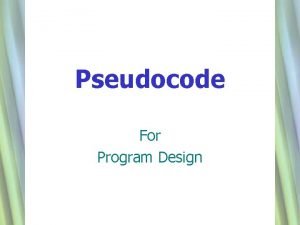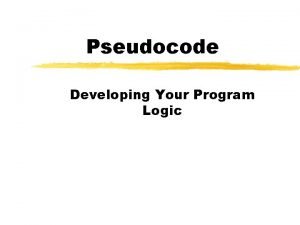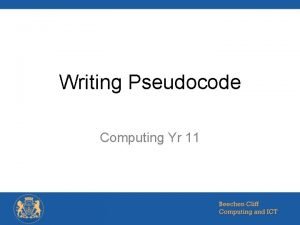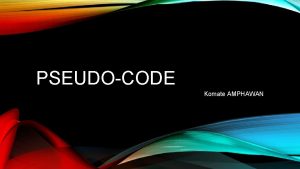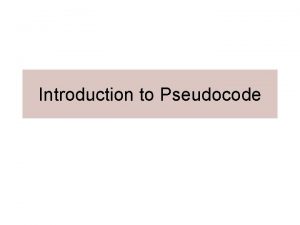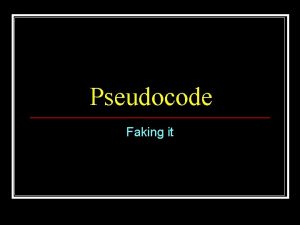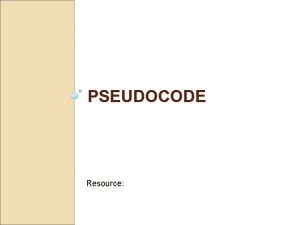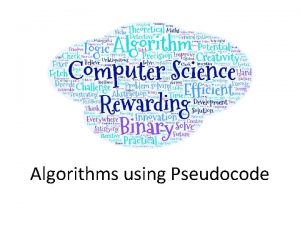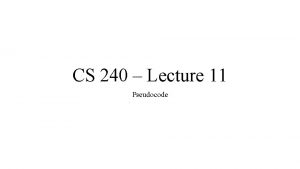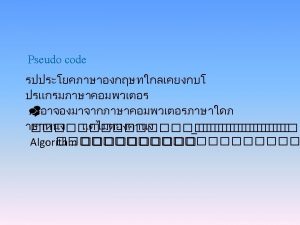Pseudocode Contents Purpose of pseudocode VCAA pseudocode conventions






















- Slides: 22

Pseudocode

Contents • Purpose of pseudocode • VCAA pseudocode conventions 2

Purpose of pseudocode • Pseudocode describes an algorithm – A strategy for calculating an answer • Rapid algorithm design – Free-form expression, no syntax rules – lets designers focus on ideas, and not be slowed down by observing strict code and punctuation rules • Pseudocode is universal – Not specific to any language – Can be converted into any language’s syntax VCE IT slideshows © 2015 -2019 Mark Kelly, vceit. com 3

Purpose of pseudocode • Clarity of meaning – If the idea behind some pseudocode is easily understood, it is successful. – If it’s confusing or impenetrably obscure, it fails. VCE IT slideshows © 2015 -2019 Mark Kelly, vceit. com 4

Pseudocode Example sub shuffle create an array of 52 integers - cards(52) loop through the array fill each array item with the index value (1 to 52) End loop through the array generate a random number (rnd) between 1 and 52 swap the value of the current slot with that of array(rnd) end loop end sub

Binary search algorithm - example pseudocode // two slashes indicate a comment // Finds the location or non-existence of value X in a data set of N items. Sort data set items in ascending order. Set Start. Point = 1 Set End. Point = N Set Exists to True Set Found to False While not Found and Exists = True Calculate data set’s middle item’s position … (Endpoint-Startpoint)/2. Store middle item’s position as Mid. Pos. Get value of item at Mid. Pos and store it as Mid. Value. If X=M then // We have found X. Set Found to True Else If X > M // throw away first half of the dataset Startpoint to Mid. Pos + 1 Else if X < M // throw away second half of dataset End. Point to Mid. Pos – 1 End if If Mid. Value = 0 then set Exists to False End While If Exists = False then display “Item X not found” else display “Item X found at position M” VCE IT slideshows © 2015 -2019 Mark Kelly, vceit. com 6

Purpose of pseudocode • The binary sort example shows typical pseudocode features. – Expression is a loose mixture of English and code – May not be 100% consistent, but makes sense – Does not dwell on finicky details that are not vitally important to the task in hand (e. g. how to sort the dataset) VCE IT slideshows © 2015 -2019 Mark Kelly, vceit. com 7

Purpose of pseudocode • The binary sort example shows typical pseudocode features. – Describes an approach to solving the problem without getting bogged down in details. – Code indentation to emphasise logical structure and flow VCE IT slideshows © 2015 -2019 Mark Kelly, vceit. com 8

Purpose of pseudocode • The binary sort example shows typical pseudocode features. – Arbitrary but consistent conventions (e. g. // to indicate comments) – Internal documentation (comments) to explain the workings of the algorithm – Meaningful object names (e. g. Start. Point) VCE IT slideshows © 2015 -2019 Mark Kelly, vceit. com 9

VCAA pseudocode conventions • While pseudocode famously has no syntax rules… • (and cannot suffer from syntax errors, so you won’t find an exam question asking about syntax errors in pseudocode!) … • VCAA has a few long-standing conventions for its pseudocode in exams. VCE IT slideshows © 2015 -2019 Mark Kelly, vceit. com 10

VCAA pseudocode conventions 1. The = symbol is only used for logical testing, e. g. if A=3 then do something 2. The symbol is used for assignment, e. g. If A=3 then B N Read it as “If A is equal to 3, then set the value of B to the value of N” VCE IT slideshows © 2015 -2019 Mark Kelly, vceit. com 11

VCAA pseudocode conventions 3. Code indentation is always used to show lines of code are controlled by • selection structures (e. g. IF, THEN, ELSE IF) or • iteration structures (e. g. WHILE, FOR loops) VCE IT slideshows © 2015 -2019 Mark Kelly, vceit. com 12

VCAA pseudocode conventions 4. Keywords may be arbitrary, but they are consistent. e. g. if GET means ‘read from a file’ and INPUT means ‘read from the keyboard’ the two terms always mean the same thing in a piece of pseudocode. VCE IT slideshows © 2015 -2019 Mark Kelly, vceit. com 13

VCAA pseudocode conventions Tip – use comments to explain the meaning of keywords that may be misinterpreted. e. g. $ $ The dollar sign precedes a comment. PRINT = output to a printer. DISPLAY = show onscreen. WRITE = save to a data file on disk. VCE IT slideshows © 2015 -2019 Mark Kelly, vceit. com 14

VCAA pseudocode conventions 5. Blocks of pseudocode usually start with BEGIN and finish with END. VCE IT slideshows © 2015 -2019 Mark Kelly, vceit. com 15

Typical Exam Pseudocode VCE IT slideshows © 2015 -2019 Mark Kelly, vceit. com

Exam Pseudocode VCE IT slideshows © 2015 -2019 Mark Kelly, vceit. com

Exam Pseudocode VCE IT slideshows © 2015 -2019 Mark Kelly, vceit. com 50

Examining Pseudocode How pseudocode is usually examined by VCAA • What is the intended output of this pseudocode? • What is the actual output of this pseudocode? • What line or lines of code cause the actual output to differ from the intended output? 50 VCE IT slideshows © 2015 -2019 Mark Kelly, vceit. com

Examining Pseudocode How pseudocode is usually examined by VCAA • What changes should be made to the pseudocode to fix the error? • How could this pseudocode be made more efficient? • Some of the pseudocode is missing. Write the pseudocode in the place it should appear. 50 VCE IT slideshows © 2015 -2019 Mark Kelly, vceit. com

Examining Pseudocode How pseudocode is usually examined by VCAA • What test data would best thoroughly test the accuracy of the pseudocode? • “Developer 1 believes the pseudocode should be changed like this. Developer 2 disagrees. Which developer is correct? Justify your answer. ” • How many times will the loop in this pseudocode be executed? • Name the search/sort algorithm used by this pseudocode. 50 VCE IT slideshows © 2015 -2019 Mark Kelly, vceit. com

Examining Pseudocode How pseudocode is usually examined by VCAA • A programmer wants to create this output… Which of these four pieces of pseudocode will best attain that goal? • Identify the line(s) of pseudocode that demonstrates a selection/repetition structure. • Why has a two-dimensional array been used in this pseudocode instead of three one-dimensional arrays? • Provide better names for the storage structures named A, B and C. 50 VCE IT slideshows © 2015 -2019 Mark Kelly, vceit. com
 Vcaa special provision
Vcaa special provision Vcaa scientific poster template
Vcaa scientific poster template Vce chemistry research investigation example
Vce chemistry research investigation example Psychology study design vcaa
Psychology study design vcaa Victorian curriculum eal
Victorian curriculum eal Vcaa audit
Vcaa audit Vce theatre studies study design
Vce theatre studies study design Biology vcaa
Biology vcaa Vcaa 2017 english exam
Vcaa 2017 english exam What is the problem
What is the problem Vcaa chinese second language
Vcaa chinese second language Studio art evaluation
Studio art evaluation Vce media study design
Vce media study design Seas application impact statement example
Seas application impact statement example Vcaa statement of results
Vcaa statement of results Production area drama
Production area drama Vce visual communication design
Vce visual communication design Vcaa curriculum mapping
Vcaa curriculum mapping Cdes psychology conference
Cdes psychology conference Vcaa music performance
Vcaa music performance Hhd study design 2021
Hhd study design 2021 Vcaa extended investigation
Vcaa extended investigation Vcaa respectful relationships
Vcaa respectful relationships








